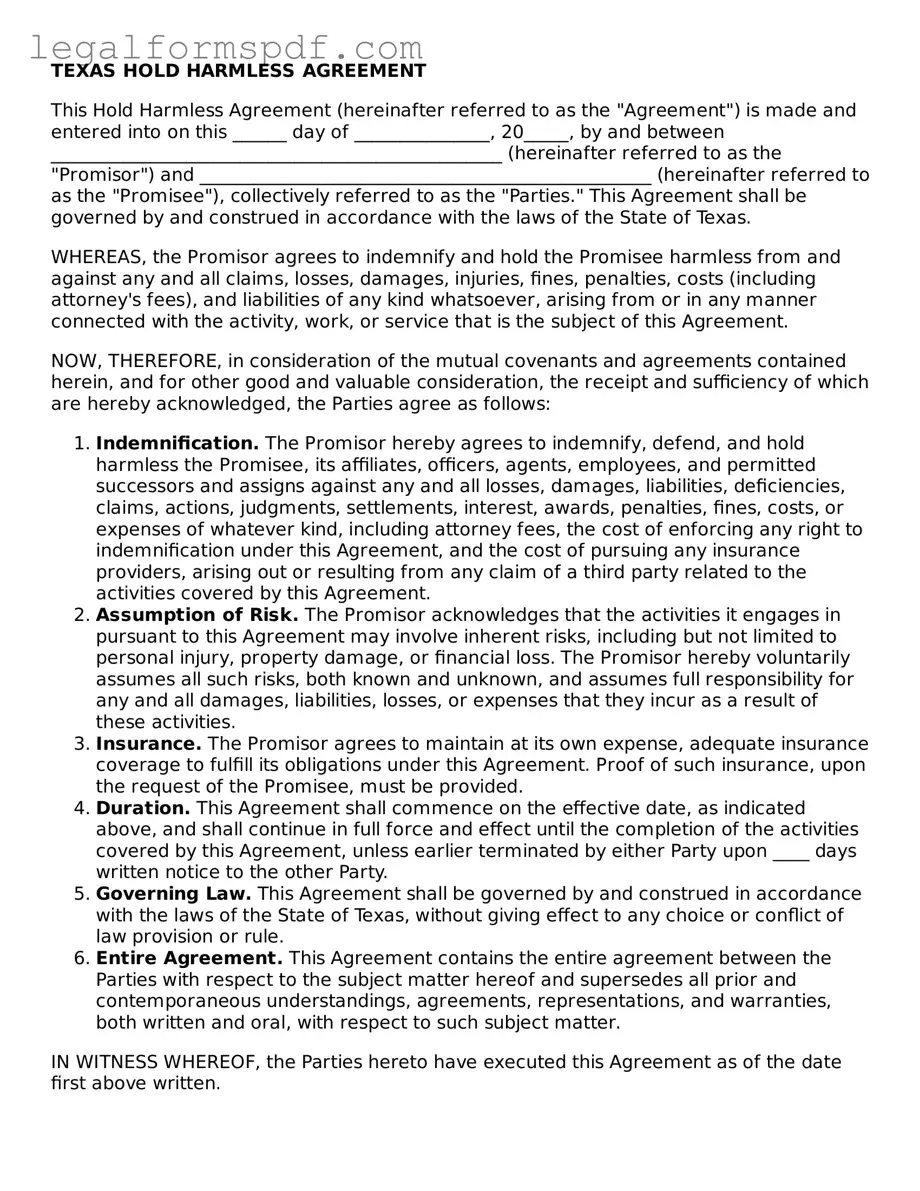TEXAS HOLD HARMLESS AGREEMENT
This Hold Harmless Agreement (hereinafter referred to as the "Agreement") is made and entered into on this ______ day of _______________, 20_____, by and between __________________________________________________ (hereinafter referred to as the "Promisor") and __________________________________________________ (hereinafter referred to as the "Promisee"), collectively referred to as the "Parties." This Agreement shall be governed by and construed in accordance with the laws of the State of Texas.
WHEREAS, the Promisor agrees to indemnify and hold the Promisee harmless from and against any and all claims, losses, damages, injuries, fines, penalties, costs (including attorney's fees), and liabilities of any kind whatsoever, arising from or in any manner connected with the activity, work, or service that is the subject of this Agreement.
NOW, THEREFORE, in consideration of the mutual covenants and agreements contained herein, and for other good and valuable consideration, the receipt and sufficiency of which are hereby acknowledged, the Parties agree as follows:
- Indemnification. The Promisor hereby agrees to indemnify, defend, and hold harmless the Promisee, its affiliates, officers, agents, employees, and permitted successors and assigns against any and all losses, damages, liabilities, deficiencies, claims, actions, judgments, settlements, interest, awards, penalties, fines, costs, or expenses of whatever kind, including attorney fees, the cost of enforcing any right to indemnification under this Agreement, and the cost of pursuing any insurance providers, arising out or resulting from any claim of a third party related to the activities covered by this Agreement.
- Assumption of Risk. The Promisor acknowledges that the activities it engages in pursuant to this Agreement may involve inherent risks, including but not limited to personal injury, property damage, or financial loss. The Promisor hereby voluntarily assumes all such risks, both known and unknown, and assumes full responsibility for any and all damages, liabilities, losses, or expenses that they incur as a result of these activities.
- Insurance. The Promisor agrees to maintain at its own expense, adequate insurance coverage to fulfill its obligations under this Agreement. Proof of such insurance, upon the request of the Promisee, must be provided.
- Duration. This Agreement shall commence on the effective date, as indicated above, and shall continue in full force and effect until the completion of the activities covered by this Agreement, unless earlier terminated by either Party upon ____ days written notice to the other Party.
- Governing Law. This Agreement shall be governed by and construed in accordance with the laws of the State of Texas, without giving effect to any choice or conflict of law provision or rule.
- Entire Agreement. This Agreement contains the entire agreement between the Parties with respect to the subject matter hereof and supersedes all prior and contemporaneous understandings, agreements, representations, and warranties, both written and oral, with respect to such subject matter.
IN WITNESS WHEREOF, the Parties hereto have executed this Agreement as of the date first above written.
______________________________
Promisor Signature
______________________________
Promisor Printed Name
______________________________
Promisee Signature
______________________________
Promisee Printed Name
